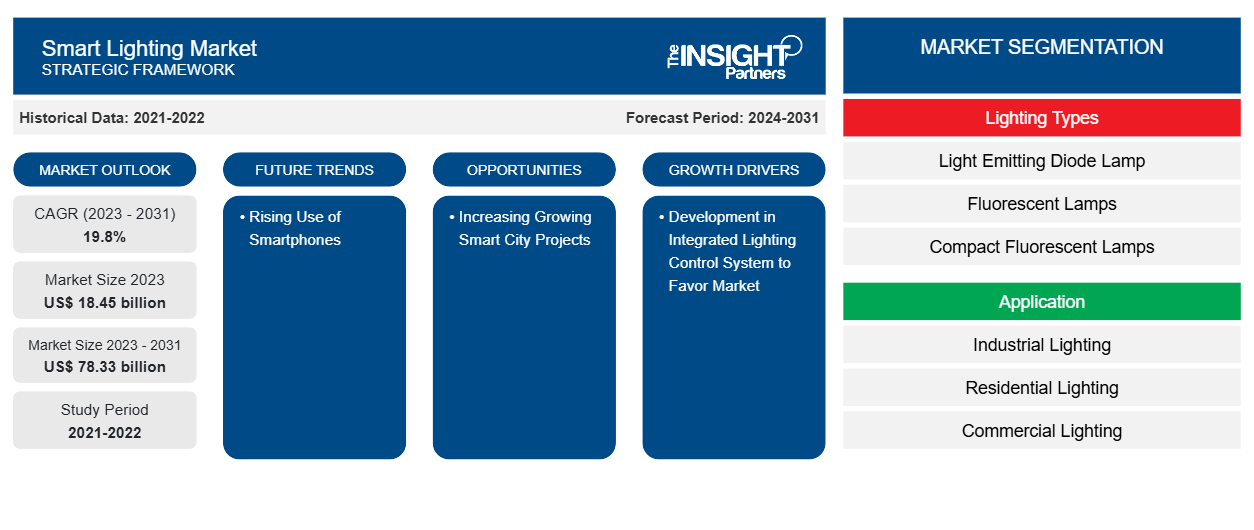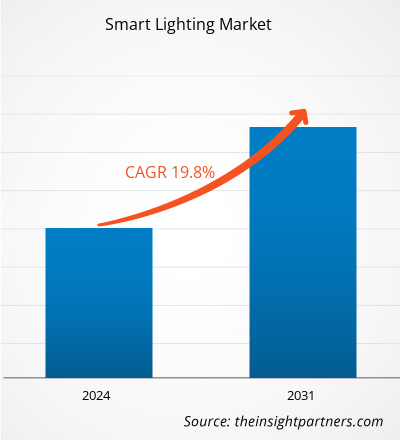The Smart Lighting Market size is projected to reach US$ 78.33 billion by 2031 from US$ 18.45 billion in 2023. The market is expected to register a CAGR of 19.8% in 2023—2031. The development of integrated lighting control systems and growing smart city projects are likely to remain key smart lighting market trends.
Smart Lighting Market Analysis
The smart lighting market is growing at a rapid pace. In recent years, the market for smart lighting has experienced substantial growth due to the ongoing and forthcoming smart city projects in developing economies.
Smart Lighting Market Overview
Lights have become more popular and in demand in both commercial and residential environments due to their capacity to link with Internet of Things devices and produce a range of ambient lighting with simple smartphones or tablets. As needed, smart lights can be dimmed to a variety of color tones. They can also be connected via Wi-Fi, Bluetooth, SmartThings, Z-Wave, or ZigBee, and they can be programmed to turn on or off. Furthermore, voice control over smart lights can be achieved through platform integration, such as Google Assistant, Microsoft Cortana, Apple Siri, and Amazon Alexa. In addition to lighting, these extensive feature sets also include an increasing number of IoT devices and smart assistant platforms, which have opened up new growth opportunities for the smart lighting market.
Customize This Report To Suit Your Requirement
You will get customization on any report - free of charge - including parts of this report, or country-level analysis, Excel Data pack, as well as avail great offers and discounts for start-ups & universities
Smart Lighting Market: Strategic Insights

-
Get Top Key Market Trends of this report.This FREE sample will include data analysis, ranging from market trends to estimates and forecasts.
Smart Lighting Market Drivers and Opportunities
Development in Integrated Lighting Control System to Favor Market
Turning on or off is made possible by the integrated control system from a single location. The cost-effectiveness of smart lighting and the increased awareness among consumers and the government alike of the need to conserve electricity are contributing to its expanding market share. The market for smart lighting has been able to grow globally because of the development of integrated lighting control systems.
Increasing Growing Smart City Projects
Because smart lighting devices are being more widely used as a result of ongoing smart city projects, the worldwide smart lighting market is anticipated to rise significantly. The governments of developing countries are making large financial investments in the creation of smart cities. For numerous suppliers in the domains of consultancy, utility services, and information technology, this offers a substantial commercial opportunity. Because maximizing the use of available electricity is one of the main objectives of smart city development, and because smart lighting is becoming more and more popular because of its efficiency, smart lighting is consistent with smart city projects. It is projected that the implementation of smart lighting will significantly aid energy savings and sustainability.
Smart Lighting Market Report Segmentation Analysis
Key segments that contributed to the derivation of the smart lighting market analysis are lighting types, applications, and connectivity technology.
- Based on lighting types, the smart lighting market is divided into light-emitting diode (LED) lamps, fluorescent lamps, compact fluorescent lamps (CFL), high-intensity discharge lamps, and others (neon lamps and photographic flashes). The LED segment held a larger market share in 2023.
- By application size, the market is segmented into industrial lighting, residential lighting, commercial lighting, government, outdoor lighting, and automotive lighting. The residential segment held the largest share of the market in 2023.
- Based on connectivity technology, the smart lighting market is divided into wired and wireless. The wireless segment held a larger market share in 2023.
Smart Lighting Market Share Analysis by Geography
The geographic scope of the Smart Lighting Market report is mainly divided into five regions: North America, Asia Pacific, Europe, Middle East & Africa, and South America/South & Central America. North America has dominated the smart lighting market. High technology adoption trends in various industries in the region have fuelled the growth of the smart lighting market. Factors such as increased adoption of digital tools and high technological spending by government agencies are expected to drive the North America smart lighting market growth. Moreover, a strong emphasis on research and development in the developed economies is forcing North American players to bring technologically advanced solutions into the market. All these factors contribute to the region's growth of the Smart Lighting Market.
Smart Lighting Market Regional Insights
The regional trends and factors influencing the Smart Lighting Market throughout the forecast period have been thoroughly explained by the analysts at The Insight Partners. This section also discusses Smart Lighting Market segments and geography across North America, Europe, Asia Pacific, Middle East and Africa, and South and Central America.
Smart Lighting Market Report Scope
| Report Attribute | Details |
|---|---|
| Market size in 2023 | US$ 18.45 billion |
| Market Size by 2031 | US$ 78.33 billion |
| Global CAGR (2023 - 2031) | 19.8% |
| Historical Data | 2021-2022 |
| Forecast period | 2024-2031 |
| Segments Covered |
By Lighting Types
|
| Regions and Countries Covered |
North America
|
| Market leaders and key company profiles |
|
Smart Lighting Market Players Density: Understanding Its Impact on Business Dynamics
The Smart Lighting Market is growing rapidly, driven by increasing end-user demand due to factors such as evolving consumer preferences, technological advancements, and greater awareness of the product's benefits. As demand rises, businesses are expanding their offerings, innovating to meet consumer needs, and capitalizing on emerging trends, which further fuels market growth.

- Get the Smart Lighting Market top key players overview
Smart Lighting Market News and Recent Developments
The Smart Lighting Market is evaluated by gathering qualitative and quantitative data post primary and secondary research, which includes important corporate publications, association data, and databases. The following is a list of developments in the market:
- In February 2023, - Signify, one of the world leaders in lighting, supplied LED street lighting, smart poles, and a connected lighting system to the industrial parks in Huanggang City in Hubei Province, China. This large-scale smart pole project will enable the province to save energy costs and emissions while digitalizing the urban infrastructure.
(Source: Signify, Press Release, 2023)
- In November 2023, in order to better seamlessly link with the Smart IoT platform and provide a more convenient smart interaction for users, Yeelight, as the authoritative solution provider in the field of smart lighting, officially rolled out an updated solution based on BLE Mesh protocol seamless setup for manufacturers and brands.
(Source: Yeelight, Press Release, 2023)
Smart Lighting Market Report Coverage and Deliverables
The "Smart Lighting Market Size and Forecast (2021–2031)" report provides a detailed analysis of the market covering below areas:
- Market size and forecast at global, regional, and country levels for all the key market segments covered under the scope.
- Market dynamics such as drivers, restraints, and key opportunities
- Key future trends
- Detailed PEST/Porter's Five Forces and SWOT analysis
- Global and regional market analysis covering key market trends, major players, regulations, and recent market developments.
- Industry landscape and competition analysis covering market concentration, heat map analysis, prominent players, and recent developments.
- Detailed company profiles
Frequently Asked Questions
What are the future trends of the global smart lighting market?
What is the estimated market size for the global smart lighting market in 2023?
What is the driving factor impacting the global smart lighting market?
What will be the market size of the global smart lighting market by 2031?
Which are the key players holding the major market share of the smart lighting market?
- Historical Analysis (2 Years), Base Year, Forecast (7 Years) with CAGR
- PEST and SWOT Analysis
- Market Size Value / Volume - Global, Regional, Country
- Industry and Competitive Landscape
- Excel Dataset
Recent Reports
Testimonials
Reason to Buy
- Informed Decision-Making
- Understanding Market Dynamics
- Competitive Analysis
- Identifying Emerging Markets
- Customer Insights
- Market Forecasts
- Risk Mitigation
- Boosting Operational Efficiency
- Strategic Planning
- Investment Justification
- Tracking Industry Innovations
- Aligning with Regulatory Trends





















 Get Free Sample For
Get Free Sample For